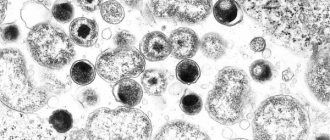Paresis of the hind limbs in cats is considered one of the most severe and dangerous conditions. The disease can also affect other parts of the body and is accompanied by partial or complete loss of movement, excessive salivation, and breathing problems. At the first symptoms of deterioration in the pet’s health, the owner should contact a veterinarian, who will prescribe treatment and rehabilitation exercises, and give preventive recommendations.
According to veterinarians, most often paraparesis develops after a fall from a window, when the cat receives a spinal injury due to the carelessness of the owner.
Causes of paralysis in cats
Almost all diseases of cats can lead to a complicated course with the occurrence of paralysis. Even such a “harmless” disease as ear scabies can lead to paralysis - first, inflammation of the middle ear occurs, then the infection spreads to the inner ear and can then affect the membranes of the brain, it is because of the latter condition that there is a danger of paralysis.
Main factors:
- Spinal injury – falling from a height can damage the vertebrae and spinal cord. Depending on the affected area, paralysis can occur in both the hind and forelimbs; most often the lesions are symmetrical. Symptoms come on suddenly and may worsen rapidly over a short period of time
- Inflammatory processes of the spinal cord - usually due to infectious processes, parasitic lesions, complicated trauma and poisoning.
- Fibrous-cartilaginous embolism is a violation of blood circulation in an organ due to blockage of a vessel with a blood, fat or tumor piece. Severe tissue ischemia and subsequent necrosis occurs.
- Stroke is damage to the blood vessels of the brain; with this pathology, its normal functioning is disrupted and motor function is impaired, up to complete paralysis.
- Ixodid tick infestation causes paralysis due to the toxins released by the tick during the bite. Occurs 6 days after the bite.
- Gas poisoning.
- A dangerous viral infection - in most cases, rabies infection leads to paralysis, the larynx is especially often affected, and breathing stops.
Postpartum paresis
This type must be considered separately. The second name is postpartum hypocalcemia . Occurs during severe “calcium starvation” in females who have just given birth (no later than three to four days after birth). The more kittens in the litter, the higher the risk of complications. For the same reasons, the risk of postpartum paresis is always higher in miniature cats. And for the same reasons, their diet before and during pregnancy should be closely monitored.
Types of paralysis in cats
There are several types of paralysis that characterize the degree of the disease. These include symmetrical lesions - paraplegia , in which both lower limbs are involved in the process at once. With hemiplegia , the thoracic and pelvic region is damaged, and paralysis affects the paws on one side of the body.
Tetraplegia is complete paralysis of all four limbs.
In monoplegia , only one limb is affected.
The disease is also divided according to the area affected:
- Facial nerve paralysis.
- Hind limbs.
- Spinal paralysis.
- Laryngeal paralysis.
- Damage to the radial nerve - this disease refers to obstetric injuries that occurred during childbirth.
Treatment and care
As a result of a comprehensive study, the doctor will give the animal a diagnosis, on which the further treatment plan will depend.
Depending on the disease that caused the paw failure, the following treatment methods for the cat are possible:
- Conservative.
- Operational.
- Physiotherapy.
Conservative method
Most diseases in the early stages can be cured with medication. If an infection is detected, the cat is prescribed antibiotics.
For dysplasia, painkillers and anti-inflammatory drugs are used. In some cases, drug treatment is effective against blood clots.
When a tick bites, antibiotics, diuretics and anticonvulsants are prescribed.
Often the animal is prescribed a diet. It is especially important to follow it if a cat is diagnosed with vitamin deficiency. In this case, vitamin-mineral complexes are also additionally prescribed.
It is important to control the weight of animals that suffer from hip dysplasia or arthritis. Obesity leads to deterioration of the cat's condition.
Surgery
Surgeries are performed in cases of closed and open spinal fractures. Surgical intervention is necessary to remove intervertebral hernias and neoplasms. It is also effective in case of blockage of blood vessels by a blood clot.
Rehabilitation and physiotherapy
Often, in order to restore mobility to paralyzed limbs, the animal must undergo a course of physical therapy. It should only be used as prescribed by a doctor. Otherwise, physical activity may worsen the animal's condition.
Often during rehabilitation the animal is prescribed a special massage. There are also a number of exercises that the owner should do with his pet:
- The paws can be developed using the “bicycle” exercise. Use your hands to carefully move your limbs back and forth.
- You should stroke and tickle the paw pads several times a day.
- Place a towel under the cat's belly. You need to take it by both ends and carefully lift the animal. The cat will try to walk forward by moving its hind legs.
Symptoms of paralysis in cats
Almost all symptoms of paralysis depend on the affected area and the causes of its occurrence. However, there are several common signs:
- “Drunk”, uncertain gait.
- Significant reduction in movement in the paws or complete paralysis.
- Severe pain - the cat may cry when touched, avoid communication, and become aggressive.
Spinal injury - weakness or loss of movement of the hind limbs, incontinence of feces and urine, the tail may also be immobile. The cat does not react in any way to touching its hind legs due to the loss of pain and tactile sensitivity.
With thrombosis , there will be a difference in the temperature of the limbs (the affected one will be cold), the absence of pulsation of the arteries in the paw, and a blue tint to the skin.
Spinal hernias are accompanied by stiffness when walking, the animal mainly lies down. He moves reluctantly, his back is hunched. When stroked, it meows. Aggressive - due to pain in the back and affected limbs.
Tick paralysis - for several days the cat is lethargic and constantly sleeps. The pupils are dilated, difficulty swallowing appears, and as a result, refusal to eat.
With laryngeal paralysis, loss or change in voice is often observed, and swallowing is complicated. Breathing becomes noisy and hoarse.
Facial paralysis can be either symmetrical or unilateral. There is increased salivation. The muzzle loses symmetry - one corner of the mouth and eye “creeps” downward, and there is no blinking or movement of facial muscles on the affected part. With bilateral lesions, the expression of the muzzle becomes dull due to the lowering of the corners of the mouth.
Radial nerve palsy - decreased activity, the forelimb is extended forward when walking and resting.
Clinical picture of the disease
Symptoms of paresis in cats depend on the type of pathology and the severity of each specific case. In the early stages, shortness of breath and restlessness may occur. Severe shortness of breath can lead to the development of alkalosis (this is not alcoholism - this is the name for increased blood alkalinity). As a result, the animal's condition will worsen even more. If a pet with paresis is breathing shallowly and very quickly, it won’t hurt to urgently take him to the veterinarian.
Muscle twitching, muscle spasms, and gait changes (stiffness and ataxia) may occur. This occurs due to a violation of neuromuscular regulation. Sometimes aggression appears, the cat howls or wheezes, severe salivation occurs, and inadequate responses to external stimuli may be observed (a sick animal jumps almost to the ceiling from the sound of steps or clapping).
Diagnosis of paralysis in cats
Laboratory diagnostics help identify the cause of the disease.
General blood, urine and biochemistry tests monitor the animal’s condition.
For a detailed check, an MRI of the brain and spine is often required.
If infection is suspected, bacteriological analysis is recommended.
To exclude neoplasms and injuries, ultrasound and radiography are usually used. It is worth conducting Doppler sonography to check the filling of blood vessels and access of blood to the extremities.
The limbs are tested for tendon reflexes, tactile and pain sensitivity. This is done in order to assess the extent of the damage.
What to do if a cat loses its paws?
Therapy is prescribed by a veterinarian individually. For injuries and thromboembolism, surgical intervention is performed. Symptomatic treatment and antibiotics alleviate the condition of a stroke or after a tick bite. In case of a herniated spine, the protrusion is removed and the displaced structures are put in place. You should massage the cat's hind legs - stroking, flexing and extending the legs, kneading. Hyperparathyroidism is treated with calcium supplements, and for vitamin deficiency, a balanced diet is prescribed.
Return to contents
Treatment of paralysis in cats
Paralysis is a serious symptom and requires immediate medical attention. Therapy will depend on the cause of the disease. It is worth preparing for the fact that the treatment will be lengthy and rarely leads to complete restoration of movements.
It is necessary to take comprehensive measures, which include nutrition, medication and physiotherapy.
In case of paralysis, it is worth giving easily digestible foods, preferably in the form of purees. Nutrition should be complete and include all the necessary vitamins.
For injuries and inflammations, I usually use anti-inflammatory steroids - metipred, preferably administered by drip three times a day.
Injections of B vitamins are used as strengthening therapy; they help speed up the recovery of damaged peripheral nerves.
Pain is relieved with non-steroidal anti-inflammatory drugs -
- Rimadyl,
- carprodil,
- Flexoprofen.
For significant pain, opioid substances are used -
- hydromorphone,
- fentanyl,
- buprenorphine.
If thromboembolism is detected, then anticoagulants are used -
- heparin,
- aspirin,
- clopidogrel.
For injuries and hernias, surgical treatment is recommended. During the operation, bone fragments are compared and the pelvis and spine are restored, and the hernia is truncated.
Tick paralysis has an etiotropic treatment - a special anti-tick serum.
Also, in order to relieve dehydration, dehydration is carried out using droppers with saline solutions.
In cases of respiratory failure, oxygen therapy or mechanical ventilation is performed.
Physiotherapy
Myoelectric stimulation and massages are often used to restore sensitivity. The latter procedure can be carried out at home with prior consultation with a doctor, since in some cases it may be contraindicated.
Perform passive movements with your paws, bending and extending the limb. Stroke and knead them, stimulate walking with the support of the animal, correctly placing the paws when walking.
Eclampsia is an acute, life-threatening condition caused by severe hypocalcemia (calcium deficiency) in dogs and cats on the eve of birth and during lactation.
In most cases, dogs with tetany (convulsive seizures caused by impaired calcium metabolism in the body) have severe hypocalcemia (less than 6.5 mg/100 ml). Eclampsia is most common in small breed dogs and less common in cats and large dogs. In most cases, eclampsia develops within 21 days after the start of lactation, although cases of the disease have been recorded in the last 2 weeks of pregnancy and 45 days after birth.
The physiological mechanisms of eclampsia have not been fully studied. The disease occurs due to hypocalcemia , which leads to changes in the electrical potentials of cell membranes, which leads to spontaneous discharge of nerve fibers and the induction of tonic or tonic-clonic contractions of skeletal muscles. of eclampsia depend on the speed and degree of decrease in the level of calcium in the bloodstream . Seizures usually appear after blood calcium levels drop below 7 mg/100 ml.
The main threat with eclampsia is that tonic muscle cramps of various localization and duration, increased electromechanical excitability of motor and sensory nerves, increased excitability of the autonomic nervous system, lead to dysfunction of internal organs. During an attack, sudden death from asphyxia or cardiac arrest is possible. With so-called latent tetany, attacks can occur under the influence of provoking factors, for example, infections or intoxications.
Symptoms
Let's divide it into three stages:
Stage 1:
| Increased excitability |
| Irritability |
| Rapid breathing |
Stage 2:
| Salivation (increased salivation) |
| Decreased activity |
| Stiffness in movement |
| Ataxia. Uncoordinated movements of the animal's limbs |
| Increased heart rate |
| Tachycardia |
| Increase in body temperature to 39.3-39.8 * C |
| Miosis (constriction of the pupil) |
Stage 3 ( the most dangerous! ):
| Respiratory depression |
| Hyperthermia (thermal overheating) |
| Cerebral edema |
Symptoms of the third stage, if veterinary care is not provided, lead to death.
First aid.
Before the animal arrives at the veterinary clinic, a warm enema with 1% saline solution can be given. You can wrap the animal in a warm blanket, apply heating pads or plastic bottles of hot water to its limbs. Never self-medicate - this is first aid!
If you notice the above symptoms in your pet, contact a veterinary clinic IMMEDIATELY
Prevention.
To prevent the development of postpartum paresis, it is necessary to feed your pet in a balanced manner during pregnancy, not to oversaturate the diet with minerals and vitamins. If your pet has a multiple litter, then artificial complementary feeding should be started as early as possible, especially if signs of eclampsia appear. For good absorption, a calcined mineral supplement in the diet should contain vitamin D and phosphorus.
Prevention
- Do not start infectious and parasitic diseases by carrying out the full course of necessary therapy.
- Do not overfeed your pet, be sure to take measures to prevent obesity.
- It is advisable to limit the cat's free movement along the street. Castrate or neuter.
- The sleeping area should be warm and located in a draft-free room.
- When walking, wear special anti-parasitic collars or drop drops on the withers.











